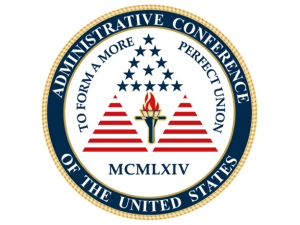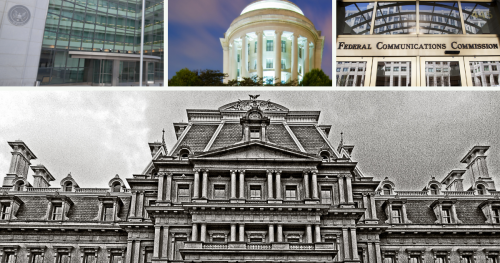Advising ACUS
What is ACUS?
The Administrative Conference of the United States (ACUS) is an independent federal agency within the executive branch charged with convening expert representatives from the public and private sectors to recommend improvements to administrative process and procedure.
ACUS initiatives promote efficiency, participation, and fairness in the promulgation of federal regulations and in the administration of federal programs.
ACUS was initially established in 1964 by the Administrative Conference Act, and it produces "nonpartisan, nonbiased, comprehensive, and practical assessments and guidance with respect to a wide range of agency processes, procedures, and practices are well documented."
Its membership is composed of innovative federal officials and experts with diverse views and backgrounds from the private sector, including academia, the practicing bar, industry and public interest organizations.
Published Reports
Scholars at the GW Regulatory Studies Center haved frequently served as consultants to ACUS, producing the following reports.
In addition to the published reports listed here, Center scholars have served in several capacities within ACUS. Susan Dudley and Bridget Dooling became Senior Fellows after serving as one of the 101 Public and Government Members of the independent agency.
Final Report on Contractors in Rulemaking
This final report sheds light on the ways that federal agencies use contractors to support the rulemaking process. We begin with a discussion of the current academic literature on outsourcing for government services and then outline legal considerations that apply to rulemaking contracts in particular. Turning to a set of in-depth interviews with 45 agency officials, experts, and contractors and a survey of agency rulemaking officials, we next unpack agency perspectives on the appropriateness of contractors in rulemaking. We then provide an inventory of dozens of discrete tasks that contractors have performed in the rulemaking context. We also explore the reasons why agencies use (or do not use) contractors when writing rules.
Mass, Computer-Generated, and Fraudulent Comments
This report explores three forms of commenting in federal rulemaking that have been enabled by technological advances: mass, fraudulent, and computer-generated comments. Mass comments arise when an agency receives a much larger number of comments in a rulemaking than it typically would (e.g., thousands when the agency typically receives a few dozen). The report focuses on a particular type of mass comment response, which it terms a “mass comment campaign,” in which organizations orchestrate the submission of large numbers of identical or nearly identical comments. Fraudulent comments, which we refer to as “malattributed comments” as discussed below, refer to comments falsely attributed to persons by whom they were not, in fact, submitted. Computer-generated comments are generated not by humans, but rather by software algorithms. Although software is the product of human actions, algorithms obviate the need for humans to generate the content of comments and submit comments to agencies.
Developing Regulatory Alternatives Through Early Input
This report offers evidence on whether and, if so, how agencies consider and disclose their review of alternative regulatory approaches as part of their rulemaking processes. Moreover, it provides information on when in the regulatory process agencies are most apt to concern themselves with alternative regulatory options. To do so, the evidence discussed in the report derives from an in-depth examination of 25 economically significant rules finalized during the Obama and Trump Administrations as well as a series of semi-structured interviews with current and former personnel from multiple agencies within five executive departments.
Agency Economists
This report examines the relationship between the organization of economists in agencies and the robustness and integrity of economic analysis that is intended to inform decisions about the design and adoption of individual regulations. It considers three methods of organizing economists who work on regulations: “divisional” organization (placement in the program office that writes regulations), “functional” organization (placement in a unit separate from the program office), and a hybrid organization that places economists in the program office but also has a central economics office that reviews regulations and the accompanying analysis.
Legal Issues in e-Rulemaking
Since the Administrative Procedure Act (APA) was enacted in 1946, the technological landscape has changed dramatically, while the basic framework for notice and comment rulemaking has largely gone unchanged. Federal regulators, looking to embrace the benefits of e-Rulemaking, face considerable ambiguity about how established legal requirements apply to the web. For example, does the APA permit agencies to require comments to be submitted online? Are agencies required to screen the content of public comments before they are placed on Regulations.gov? Are electronic dockets a legally sufficient means of preserving the rulemaking record? Many of these issues, and others, have been swirling around e-Rulemaking since its inception, and exist whether rulemaking is accomplished entirely on paper, or using more electronic means. This Report focuses on the legal issues that present themselves entirely, or more prominently, when agencies engage in e-Rulemaking.
This Report examines the legal issues agencies face in e-Rulemaking, and suggests how agencies can best approach those issues. Following a short background section on e-Rulemaking, Part I explains why updating the APA to address e-Rulemaking is unnecessary. Part II explores whether and how agencies should screen public comments before sharing them online, and suggests a fundamental change to the way comments are posted on the biggest online rulemaking website, Regulations.gov. Part III analyzes the legal issues associated with using an electronic docket to compile the rulemaking record, finding that well-designed electronic dockets pose no significant legal risks but that the courts could probably do more to embrace electronic filing. Part IV shows that the most basic of Federal requirements, the recordkeeping requirements of the Federal Records Act apply to e-Rulemaking and suggests ways to ensure compliance. The Report concludes with Part V, a recap of the Report's recommendations for consideration by the Rulemaking Committee of the Administrative Conference of the United States
Public Commenting on Federal Agency Regulations
This report investigates agency practices in soliciting, circulating, and responding to public comments during the federal rulemaking process. Specifically, the report develops recommendations regarding the following aspects of the public commenting:
1. Should there be a required, or at least recommended, minimum length for a comment period?
2. Should agencies immediately make comments publicly available? Should they permit a “reply comment” period?
3. Must agencies reply to all comments, even if they take no further action on a rule for years? Do comments eventually become sufficiently “stale” that they could not support a final rule without further comment?
4. Under what circumstances should an agency be permitted to keep comments confidential and/or anonymous?
5. What effects do comments actually have on agency rules?








